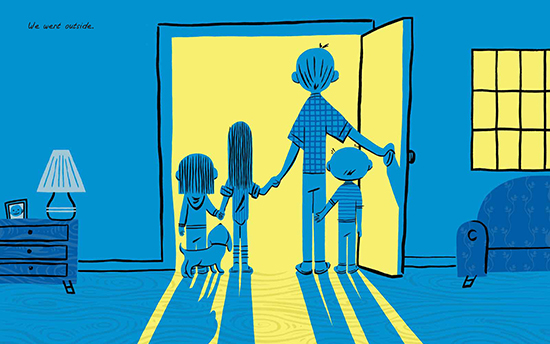“It was a dark and stormy night.” Everyone knows that cliché’d opening sentence, but I’ve always kind of enjoyed it. Cliches generally exist because they’re somewhat effective at what they’re trying to do, and therefore get overused. And a storm really is a great way to start a story! Storms are dynamic and interesting; they can vary in degrees of fierceness, they can evoke strong emotions. And, as in the book I’m writing about today, they can serve as excellent metaphors.
Dan Yaccarino’s The Longest Storm is, indeed, a book about a storm. That’s the plot. There’s a very long storm, during which a dad and his kids have to stay inside, and they get mad at each other, stomp off alone, eventually forgive each other, improve their attitudes, and go outside when the storm is over. A reader could pick up the book, cruise through it while taking note of that simple plot, and be done. But if this book was only about a big storm, I don’t think there would be tears in my eyes each time I’ve finished it.
The past few years have made us all perhaps a bit quicker to recognize stories of grief and loss when we see them, and that’s exactly the story Yaccarino’s presenting here, in a gentle, kid-friendly way. The family in these pages is dealing with a loss. What type of loss is a question that isn’t directly addressed, and that’s partly why I love the story. It’s clearly a single-parent home, and background clues suggest that perhaps the mother has passed away or left the family. The storm keeps everyone stuck inside and isolated, just like we’ve all experienced during the pandemic—and that’s certainly a cause of grief and loss, as well. But I don’t think the exact nature of the loss is what’s important to the story here. Instead, its power lies in showing the reader the process of grieving. Thinking about the early losses of activity during the pandemic made me especially resonate with the sentence, “There was nothing to do, and too much time to do it in.” Tempers are lost. Family members stop speaking to each other. “Everyone just wanted to be alone. At least that way we wouldn’t get so mad all the time.” Finally, the tipping point comes with a huge burst of lightning and a power outage. (The illustration for this moment is almost a color-blocked spread with just black, yellow, and blue—it looks really neat, and evokes precisely that startling feeling that a burst of lightning in the middle of the night gives you.) Something shifts in that moment, and after that, “things started to get better, a little every day.” But the resolution isn’t quick. An ill-advised self-haircut illustrated on one of the early pages and still pretty raggedy during the storm’s high point is almost grown out by the end, showing the long path this family has been on.
It always seems to take longer than I want it to for things to feel “normal” again after a loss. I so appreciate this book’s attempt to speak to kids (and grown-ups!) going through that process, and in a way that’s not too heavy. Like I mentioned at the beginning, a reader could pick up this book and come away simply thinking, “I’m so glad that long storm ended!” But I’m thankful for the deeper metaphor it provides for those searching for a story that matches their experience. I’ve been in the habit of buying the book Tear Soup by Pat Schwiebert and Chuck DeKlyen (which I also recommend!) to individuals or families who I know have suffered a loss, but I think I’ll be adding this one to that purchase list.
**Featured image courtesy of the author’s website.
- Michael Morpugo’s “The Puffin Keeper” - February 14, 2024
- Making the World More Beautiful (with Miss Rumphius) - May 17, 2023
- How Much is Enough? - February 8, 2023

What a thoughtful review! Thankful for books like these!